Preparation of Micro-Electrolytic Iron-Carbon Filler for Sewage by Recycling Metallurgical Dust
Abstract
:1. Introduction
2. Materials and Methods
2.1. Materials
- (1)
- Blast furnace dust
- (2)
- Iron ore powder
- (3)
- Coal tar pitch
2.2. Micro-Electrolytic Packing Preparation Method
2.3. Treatment of Simulated Wastewater
2.4. Analysis of Physical and Chemical Properties
3. Results and Discussion
3.1. Study on the Effect of Preparation Conditions on the Performance of Fillers
3.1.1. The Effect of Iron-Carbon Ratio on the Properties of Filler
3.1.2. Effect of Sintering Time on Filler Performance
3.1.3. Effect of Sintering Temperature on Filler Performance
3.2. Study of the Effect of Treatment Conditions on the Wastewater Treatment
3.2.1. Amount of Filler Addition
3.2.2. Treatment Temperature
3.2.3. Initial pH
3.3. Mechanism of Treating Methyl Orange with Micro-Electrolytic Filler
4. Conclusions
- (1)
- The optimal ratio of micro-electrolytic packing is an iron-carbon ratio of 1:2. A high iron–C ratio will reduce the reduction of iron minerals in the raw material, while a low iron–C ratio will reduce the zero-valent iron content of the prepared micro-electrolytic filler.
- (2)
- The optimal sintering time of the micro-electrolytic filler was 30 min. Too short a sintering time will decrease the reduced zero-valent iron, and too long a sintering time will increase the graphitization of C in the filler, both of which are not conducive to improving the treatment effect of wastewater.
- (3)
- The best sintering temperature of the micro-electrolysis filler was 1100 °C. If the sintering temperature is too low, the reduction degree of iron minerals in the filler will be low. If the sintering temperature is too high, the graphitization degree of carbon in the filler increases, and its activity decreases, which is not conducive to the treatment of wastewater.
- (4)
- Increasing the filler addition, raising the treatment temperature, and lowering the pH of the simulated wastewater can effectively improve the treatment efficiency of methyl orange wastewater. When the filler addition amount was 5 g, the treatment temperature was 40 °C, and the initial pH of methyl orange was 3, the removal rate of methyl orange-simulated wastewater reached a maximum of more than 99%.
Author Contributions
Funding
Institutional Review Board Statement
Informed Consent Statement
Data Availability Statement
Conflicts of Interest
References
- Xiao, X.; Zhang, S.; Sher, F.; Chen, J.; Xin, Y.; You, Z.; Wen, L.; Hu, M.; Qiu, G. A Review on Recycling and Reutilization of Blast Furnace Dust as a Secondary Resource. J. Sustain. Metall. 2021, 7, 340–357. [Google Scholar] [CrossRef]
- Li, Y.; Feng, H.; Wang, J.; She, X.; Wang, G.; Zuo, H.; Xue, Q. Current status of the technology for utilizing difficult-to-treat dust and sludge produced from the steel industry. J. Clean. Prod. 2022, 367, 132909. [Google Scholar] [CrossRef]
- Lei, Y.B.; Wei, X.; Xie, Y.Y.; Wei, W.Y.; Wang, Y. Status and progress of metallurgical dust sludge treatment technology and resource utilization. Shanxi Metall. 2019, 42, 96–99. [Google Scholar]
- Zhang, Y.X. Current situation and development direction of resource utilization of metallurgical dust and sludge of iron and steel in China. Archit. Eng. Technol. Des. 2018, 6, 3860. [Google Scholar]
- Han, X. Metallurgical dust sludge resource comprehensive utilization industry status and suggestions. Ind. Anal. 2018, 10, 201. [Google Scholar]
- Guo, X.J.; Shu, X.W.; Liang, G.; Liu, Y.F. Iron-containing dust sludge treatment and utilization process in iron and steel enterprises. Environ. Eng. 2011, 29, 96–98. [Google Scholar]
- Wang, Q.; Gui, Y.L.; Song, C.Y. Technology status and prospect of re-sourcing metallurgical iron-bearing dust sludge. J. North China Univ. Sci. Technol. Nat. Sci. Ed. 2013, 35, 19–23. [Google Scholar]
- Meng, X.F. Comprehensive utilization of dust in sintering process. Heilongjiang Met. 2016, 36, 59–62. [Google Scholar]
- Zhang, Y.L.; Zhang, D.G. Research and application of comprehensive utilization technology of primary dust removal ash in converter. In Proceedings of the National Steelmaking Academic Conference Report and Abstract Set, Changsha, China, 19–20 May 2016; p. 185. [Google Scholar]
- Zhang, J.L.; Yan, Y.F.; Xu, M.; Zhao, X.-H.; Zhang, X.-D. Research on Removal of Zn From Blast Furnace Dust. Iron Steel 2006, 41, 178–190. [Google Scholar]
- Yu, H.; Huang, X.; Li, K.; Li, Q. Present Situation and Prospect of Comprehensive Utilization of Precipitator Dust in Iron and Steel Enterprises. Conserv. Util. Miner. Resour. 2021, 41, 164–171. [Google Scholar]
- Wang, D.; Zhu, D.; Pan, J.; Guo, Z.; Yang, C.; Wang, X.; Dong, T. An Investigation into the Alkali Metals Removal from Zn-Bearing Dust Pellets in Direct Reduction. JOM 2022, 74, 634–643. [Google Scholar] [CrossRef]
- Lanzerstorfer, C.; Bamberger -Strassmayr, B.; Pilz, K. Recycling of blast furnace dust in the iron ore sintering process: Investigation of coke breeze substitution and the influence on off-gas emissions. ISIJ Int. 2015, 55, 758–764. [Google Scholar] [CrossRef] [Green Version]
- Wang, J.; Zhang, Y.; Cui, K.; Fu, T.; Gao, J.J.; Hussian, S.; Saad AlGarni, T. Pyrometallurgical recovery of zinc and valuable metals from electric arc furnace dust—A review. J. Clean. Prod. 2021, 298, 126788. [Google Scholar] [CrossRef]
- Yang, S.Z.; Sun, H.N.; Su, S.P.; Han, G.; Huang, Y. Fabrication, characterizations and performance of a high-efficiency micro-electrolysis filler for isobutyl xanthate (IBX) degradation. J. Hazard. Mater. 2021, 403, 123460. [Google Scholar] [CrossRef] [PubMed]
- Ying, D.W.; Peng, J.; Xu, X.Y.; Li, K.; Jia, J. Treatment of mature landfill leachate by internal micro-electrolysis integrated with coagulation: A comparative study on a novel sequencing batch reactor based on zero valent iron. J. Hazard. Mater. 2012, 229, 426–433. [Google Scholar] [CrossRef]
- Lai, B.; Zhou, Y.X.; Yang, P.; Yang, J.; Wang, J. Degradation of 3,3′-iminobis-propane nitrile in aqueous solution by Fe-0/GAC micro-electrolysis system. Chemosphere: Environ. Toxicol. Risk Assess. 2013, 90, 1470–1477. [Google Scholar] [CrossRef] [PubMed]
- Lai, B.; Zhou, Y.X.; Yang, P. Passivation of Sponge Iron and GAC in Fe0/GAC Mixed-Potential Corrosion Reactor. Ind. Eng. Chem. Res. 2012, 51, 7777–7785. [Google Scholar] [CrossRef]
- Cheng, H.; Xu, W.; Liu, J.; Wang, H.; He, Y.; Chen, G. Pretreatment of wastewater from triazine manufacturing by coagulation, electrolysis, and internal micro-electrolysis. J. Hazard. Mater. 2006, 146, 385–392. [Google Scholar] [CrossRef]
- Wang, X.; Gong, X.; Zhang, Q.; Du, H. Degradation mechanism of Direct Pink 12B treated by iron-carbon micro-electrolysis and Fenton reaction. J. Environ. Sci. 2013, 25, S63–S68. [Google Scholar] [CrossRef]
- Ning, X.A.; Wen, W.; Zhang, Y.; Li, R.; Sun, J.; Wang, Y.; Yang, Z.; Liu, J. Enhanced dewaterability of textile dyeing sludge using micro-electrolysis pretreatment. J. Environ. Manag. 2015, 161, 181–187. [Google Scholar] [CrossRef]
- Zheng, Z.B.; Chen, Y.X. Preparation of new iron-carbon micro-electrolytic fillers and their treatment in printing and dyeing wastewater. Guangdong Chem. Ind. 2018, 45, 46–47. [Google Scholar]
- Shen, C.H. Preparation of Iron-Carbon Micro-Electrolytic Filler by Modification of High Iron Red Mud and Its Treatment of Wastewater; Jiangxi University of Science and Technology: Ganzhou, China, 2018. [Google Scholar]
- Ao, L.; Xia, F.; Ren, Y.; Xu, J.; Shi, D.; Zhang, S.; He, Q. Enhanced nitrate removal by micro-electrolysis using Fe-0 and surfactant modified activated carbon. Chem. Eng. J. 2019, 357, 180–187. [Google Scholar] [CrossRef]
- Liu, Y.Z.; Wang, C.; Sui, Z.Y.; Zou, D. Degradation of chlortetracycline using nano micro-electrolysis materials with loading copper. Sep. Purif. Technol. 2018, 203, 29–35. [Google Scholar] [CrossRef]
- Huang, C.; Peng, F.; Guo, H.J.; Wang, C.; Luo, M.-T.; Zhao, C.; Xiong, L.; Chen, X.-F.; Chen, X.-D. Efficient COD degradation of turpentine processing wastewater by combination of Fe-C micro-electrolysis and Fenton treatment: Long-term study and scale up. Chem. Eng. J. 2018, 351, 697–707. [Google Scholar] [CrossRef]
- Sun, W.L.; Qu, Y.Z.; Yu, Q. Adsorption of organic pollutants from coking and papermaking wastewaters by bottom ash. J. Hazard. Mater. 2008, 154, 595–601. [Google Scholar] [CrossRef] [PubMed]
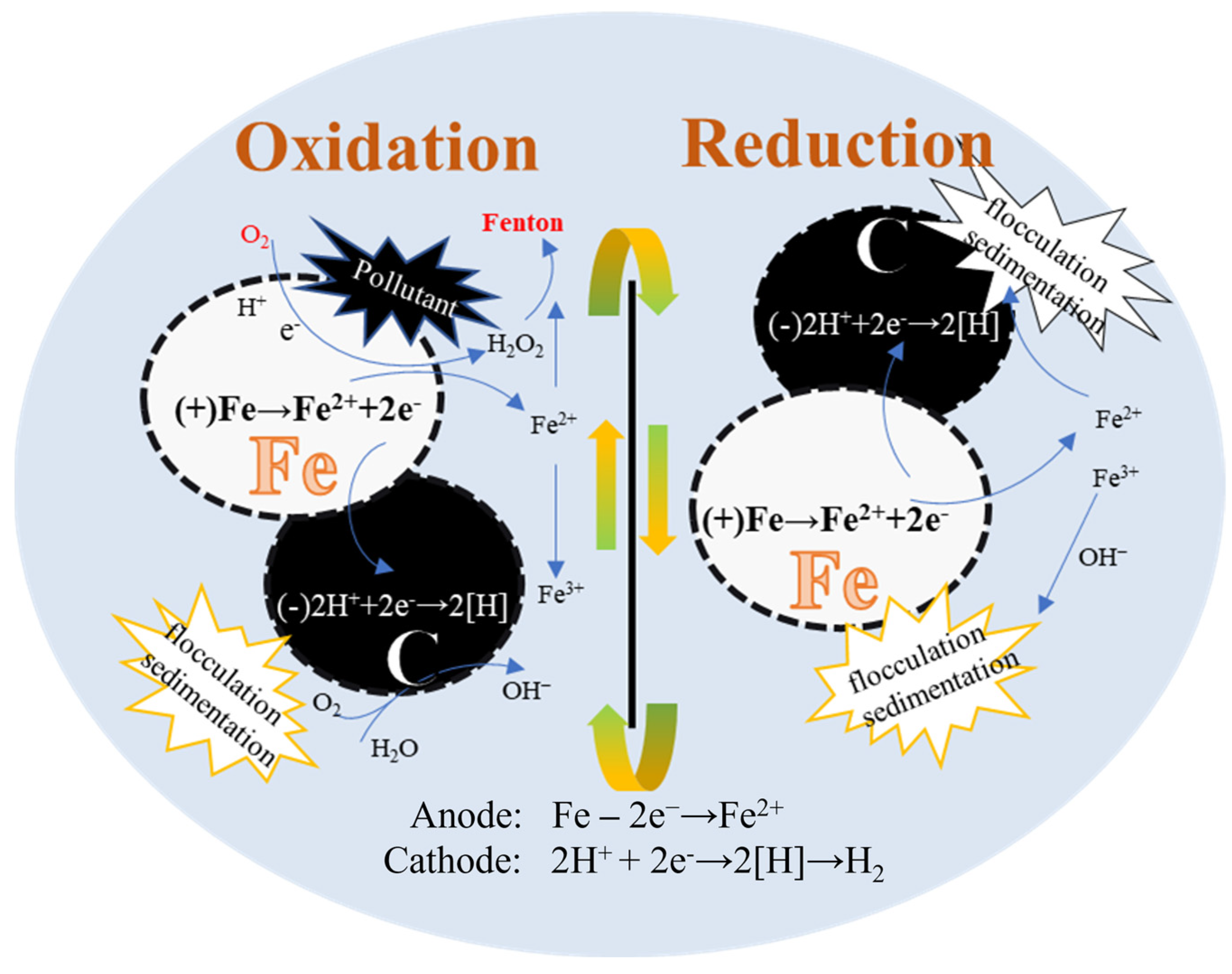
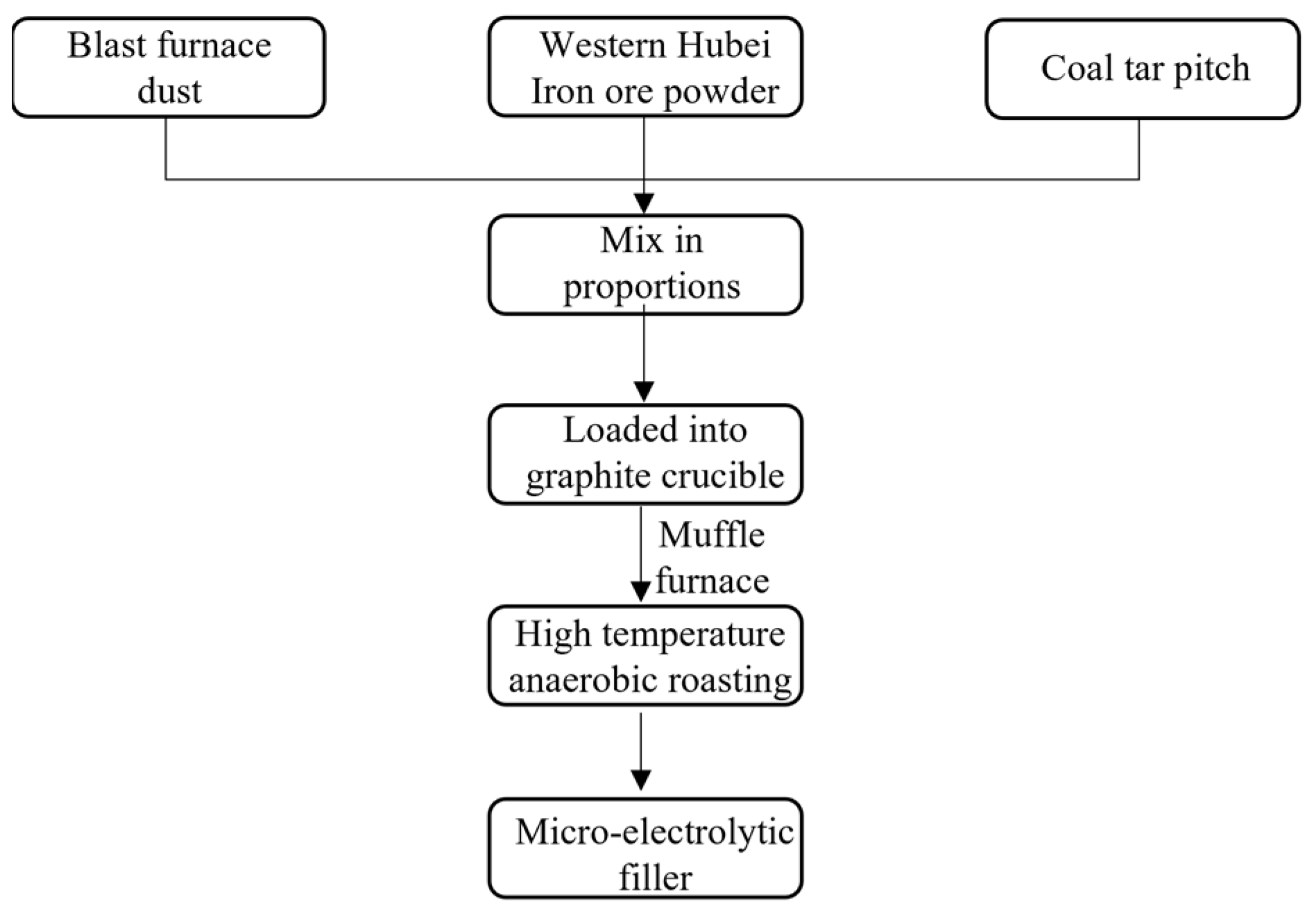
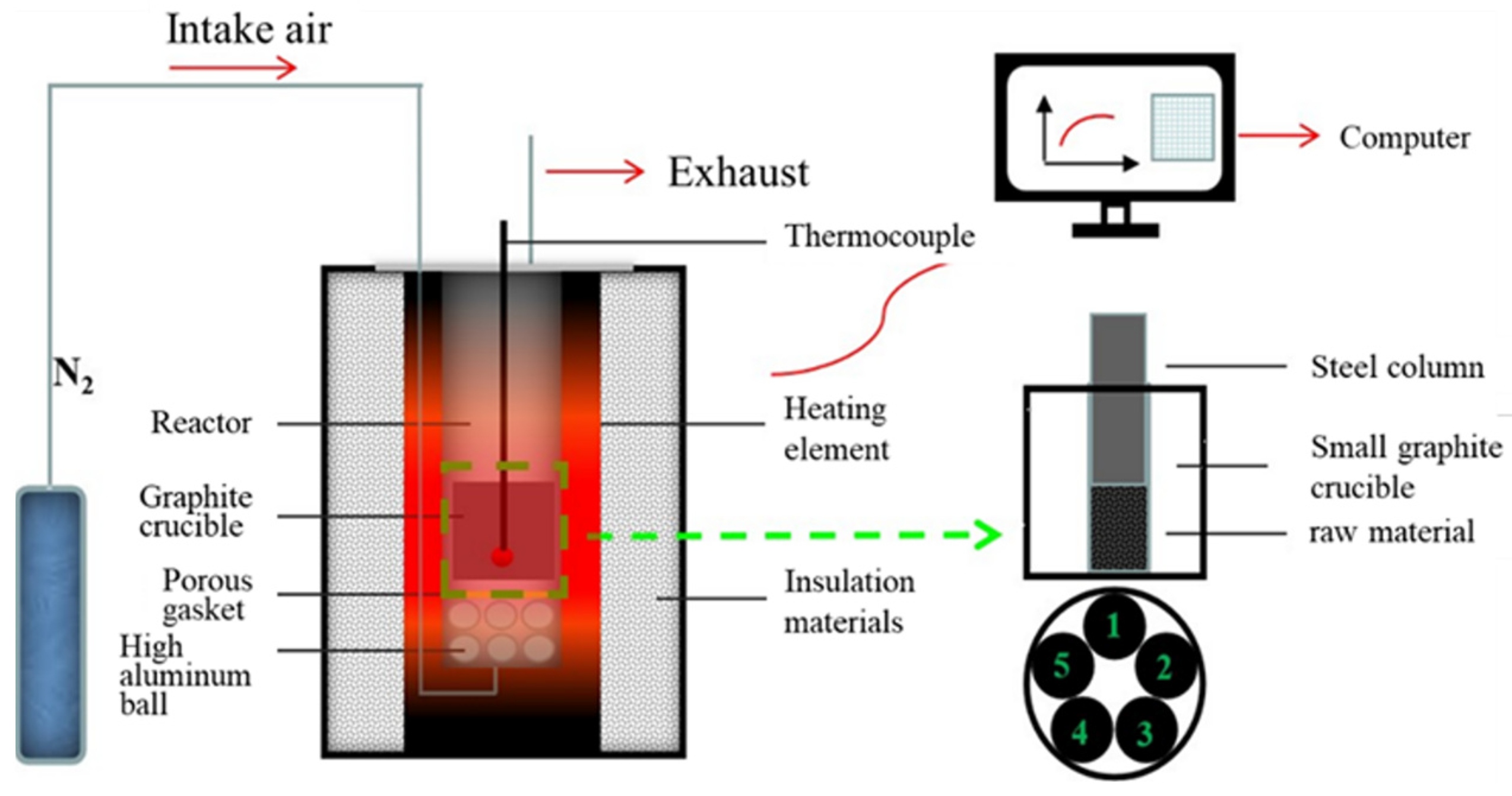


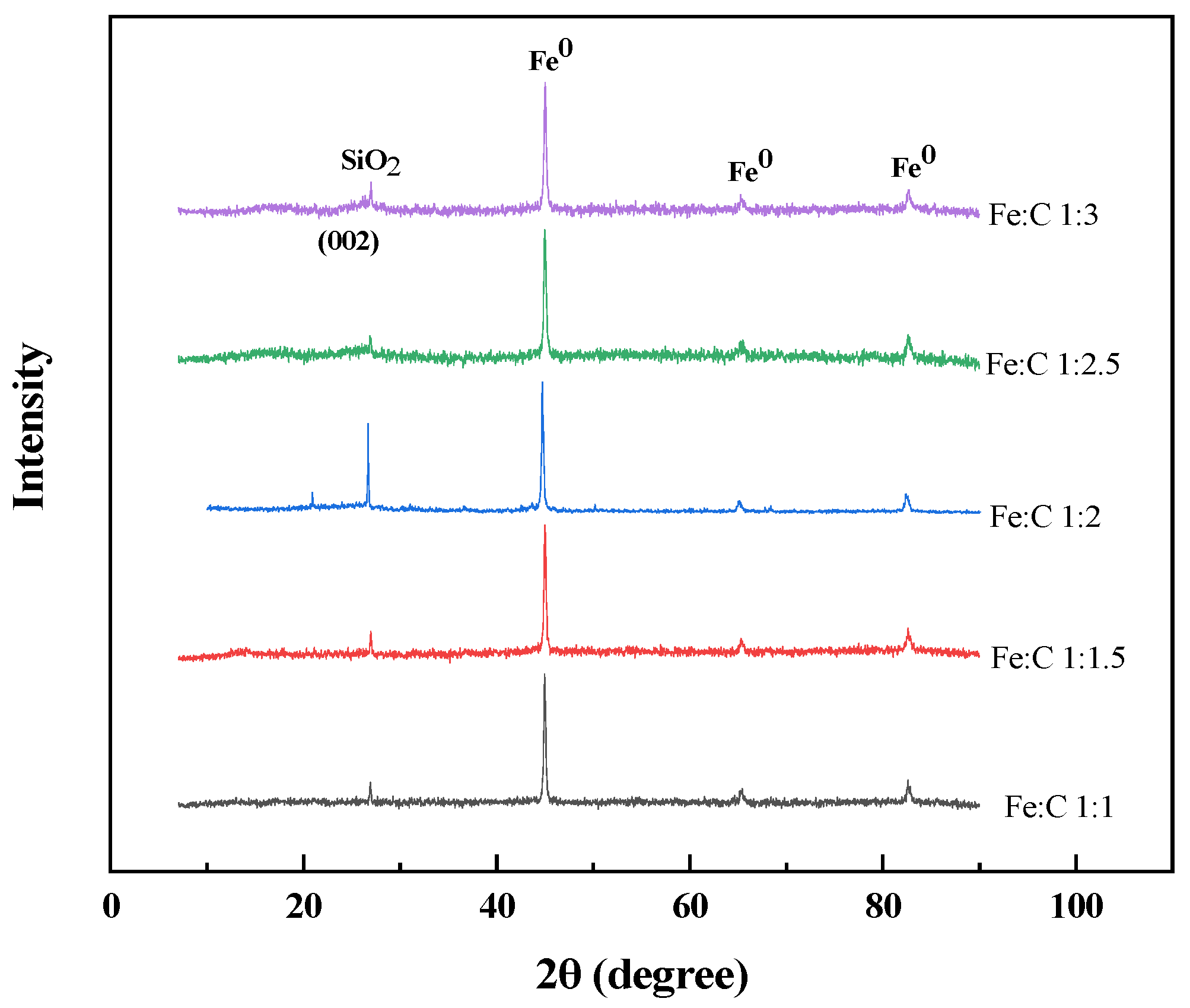
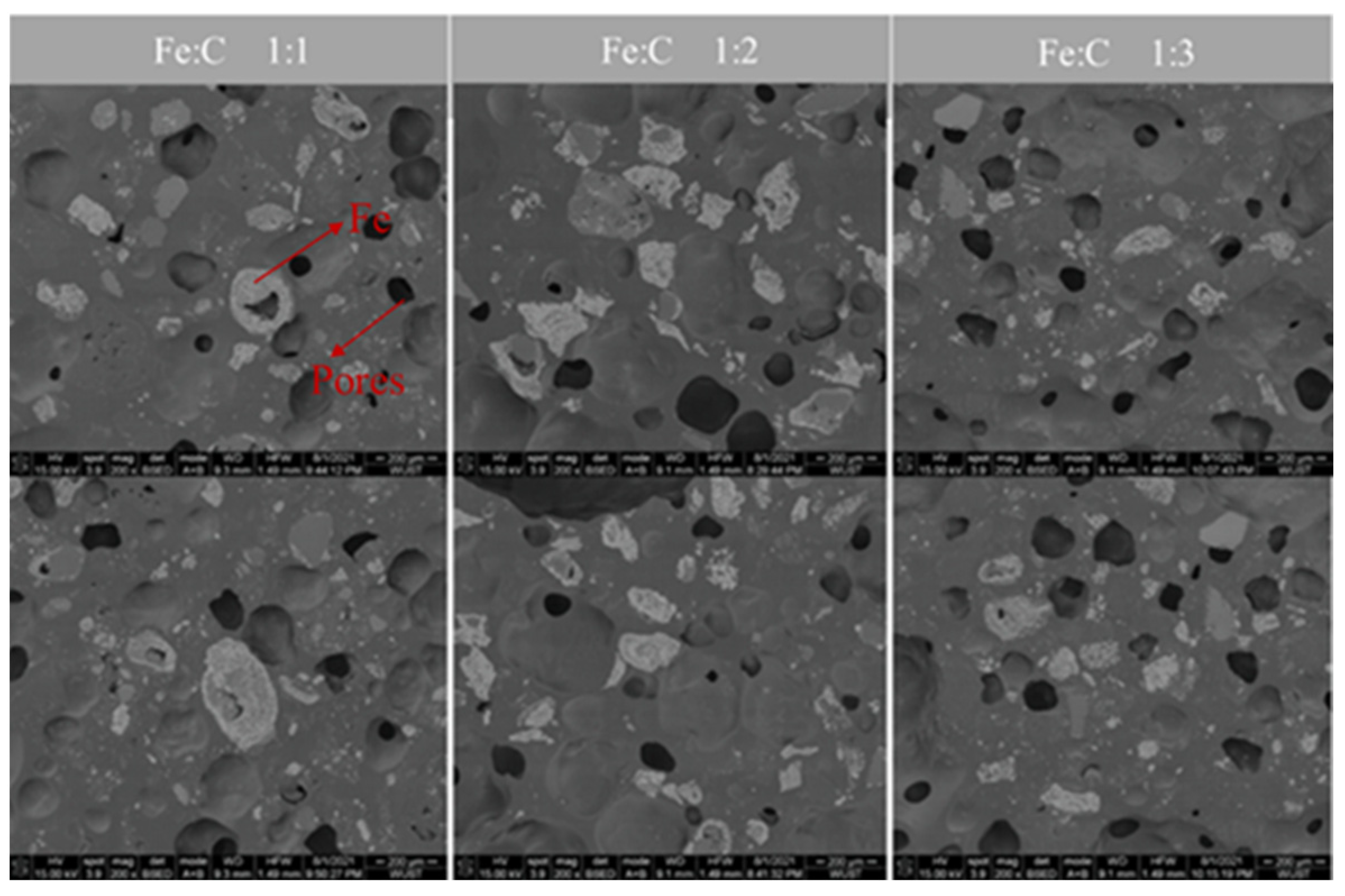
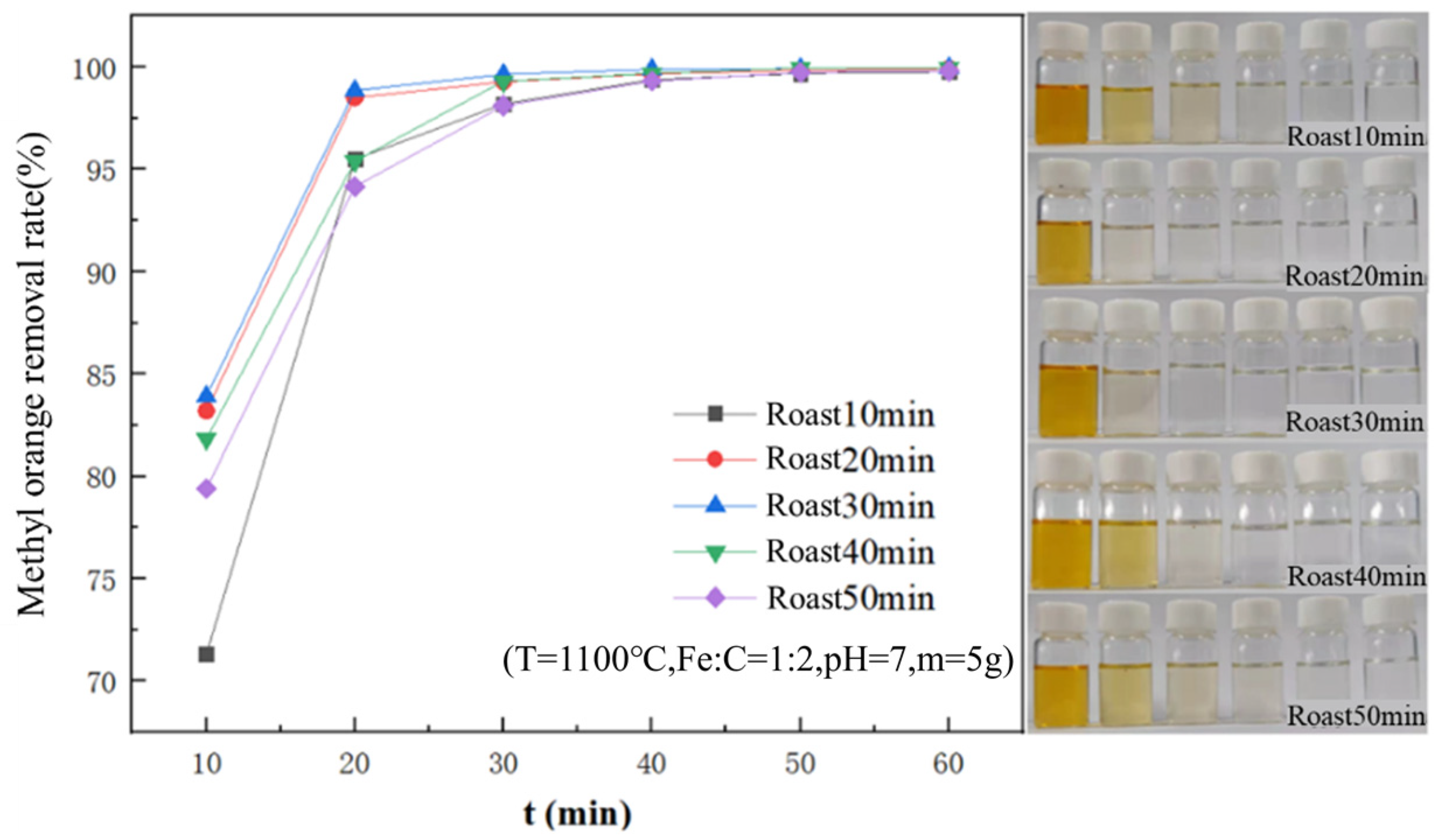
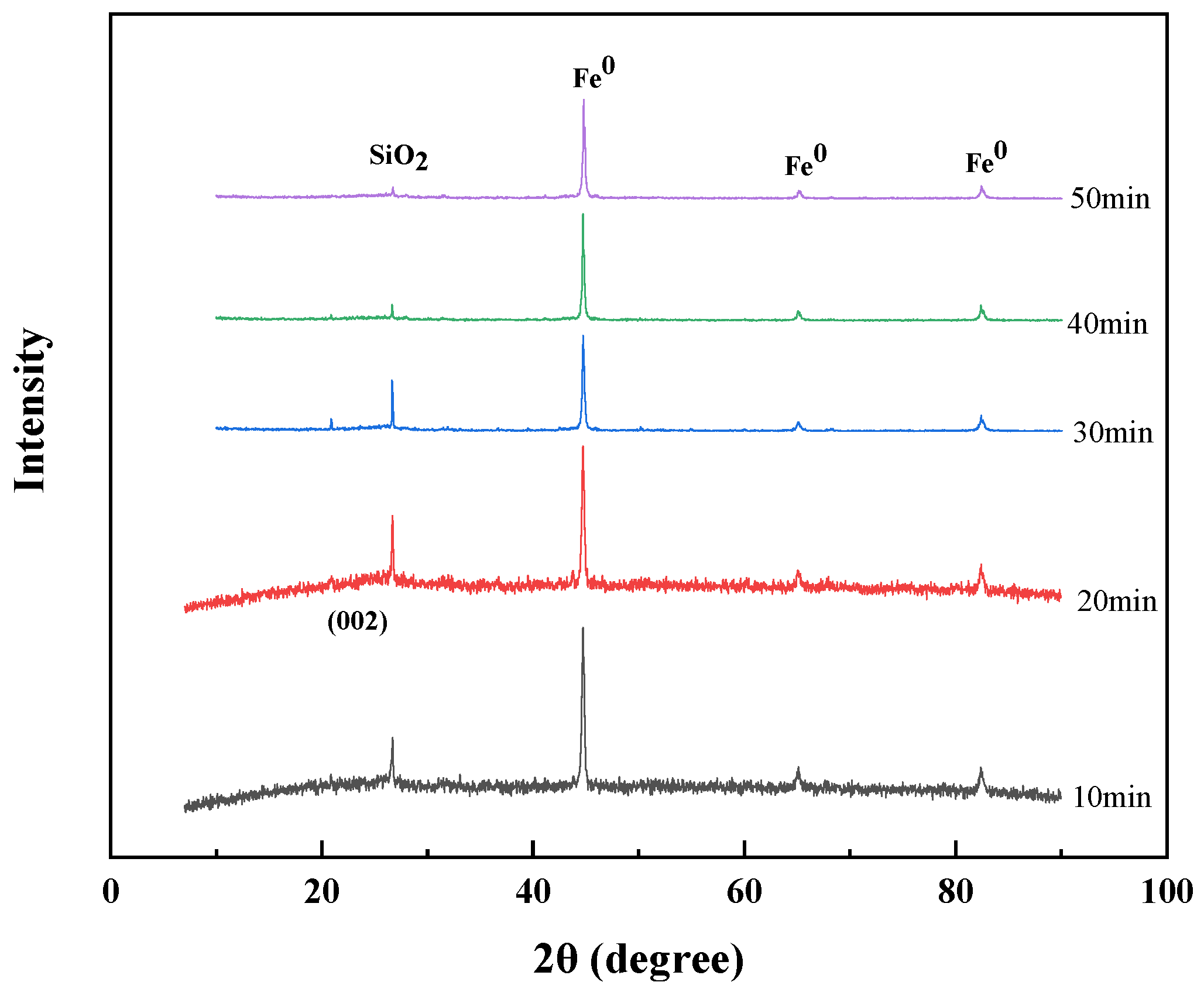

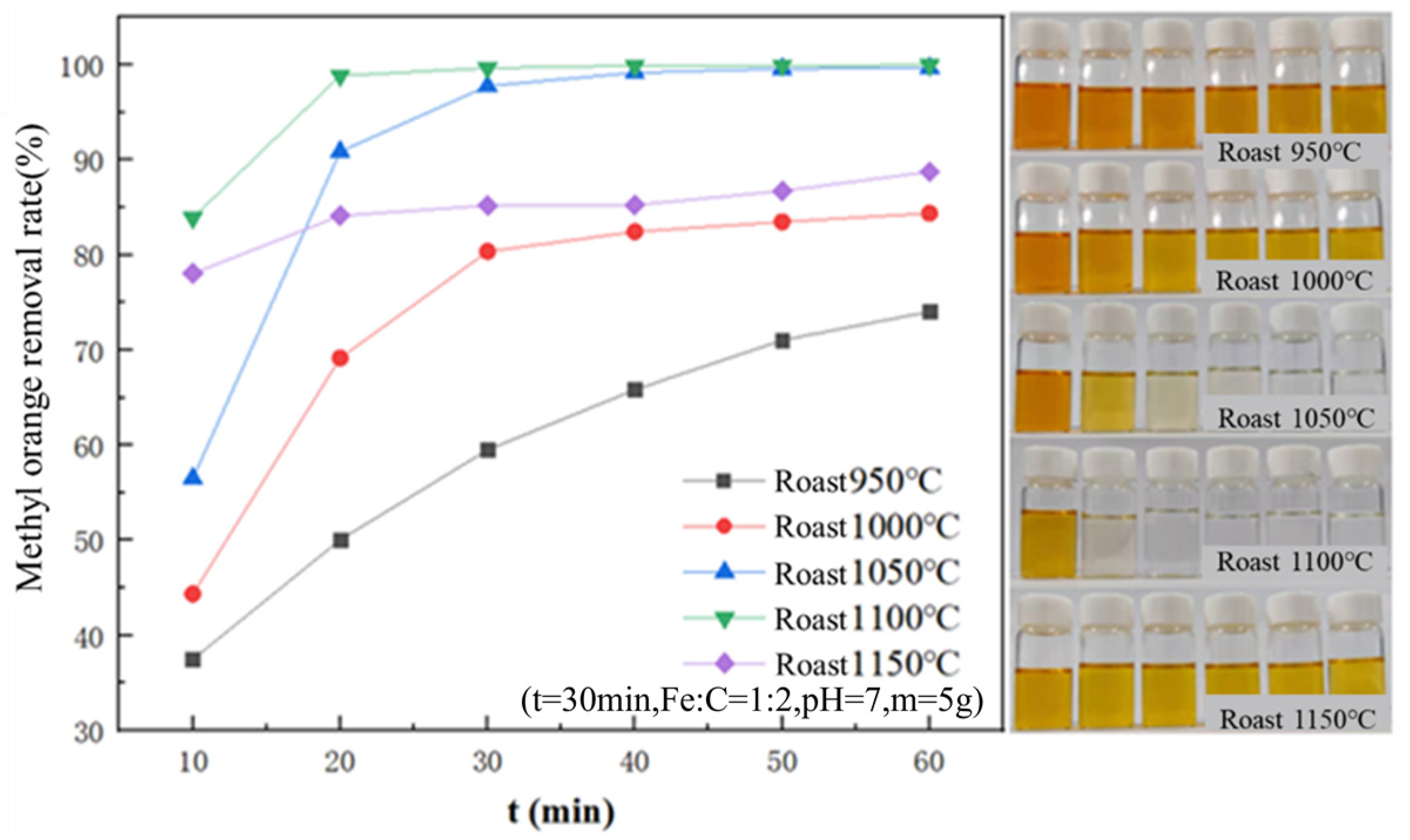
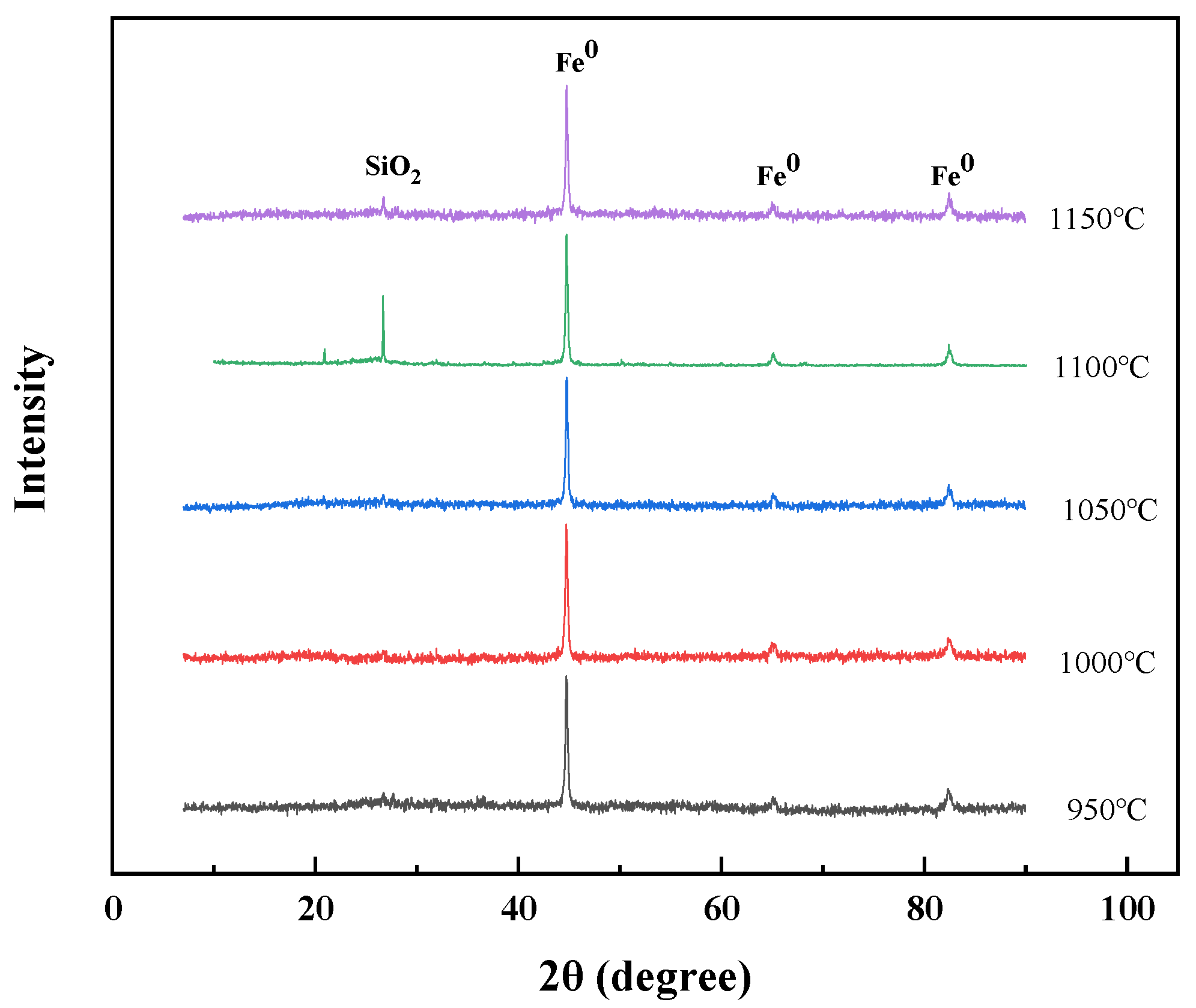
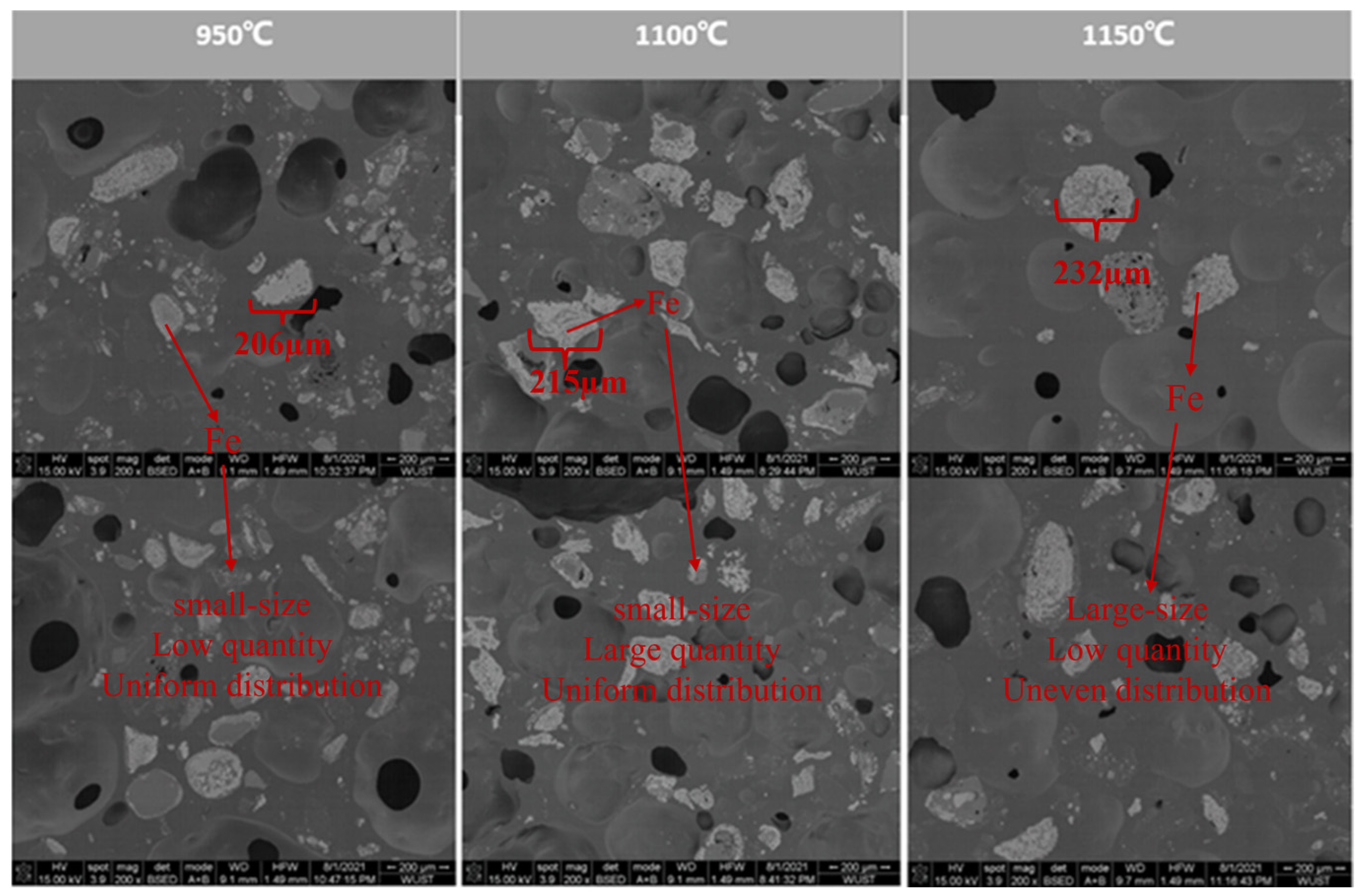
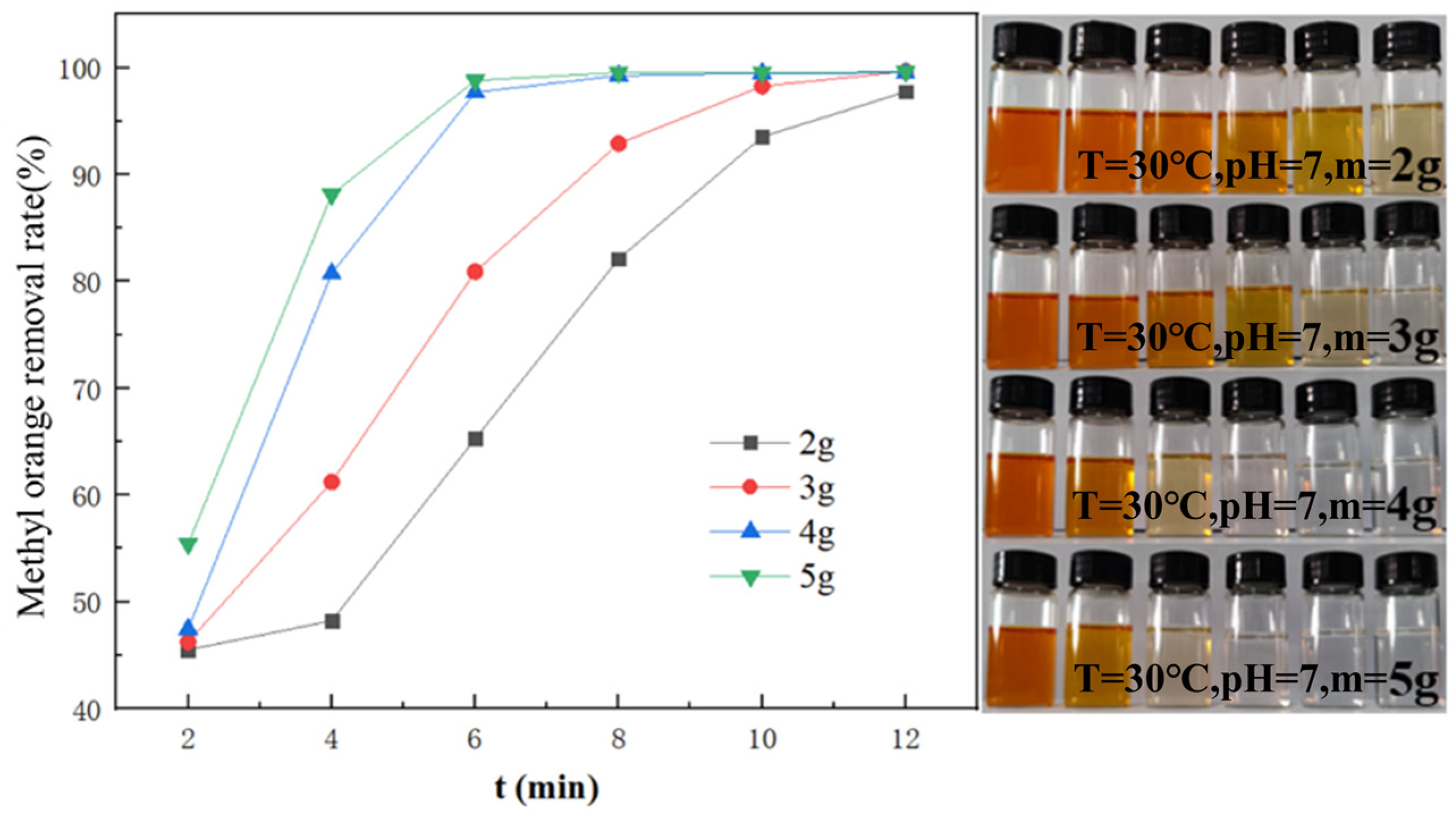
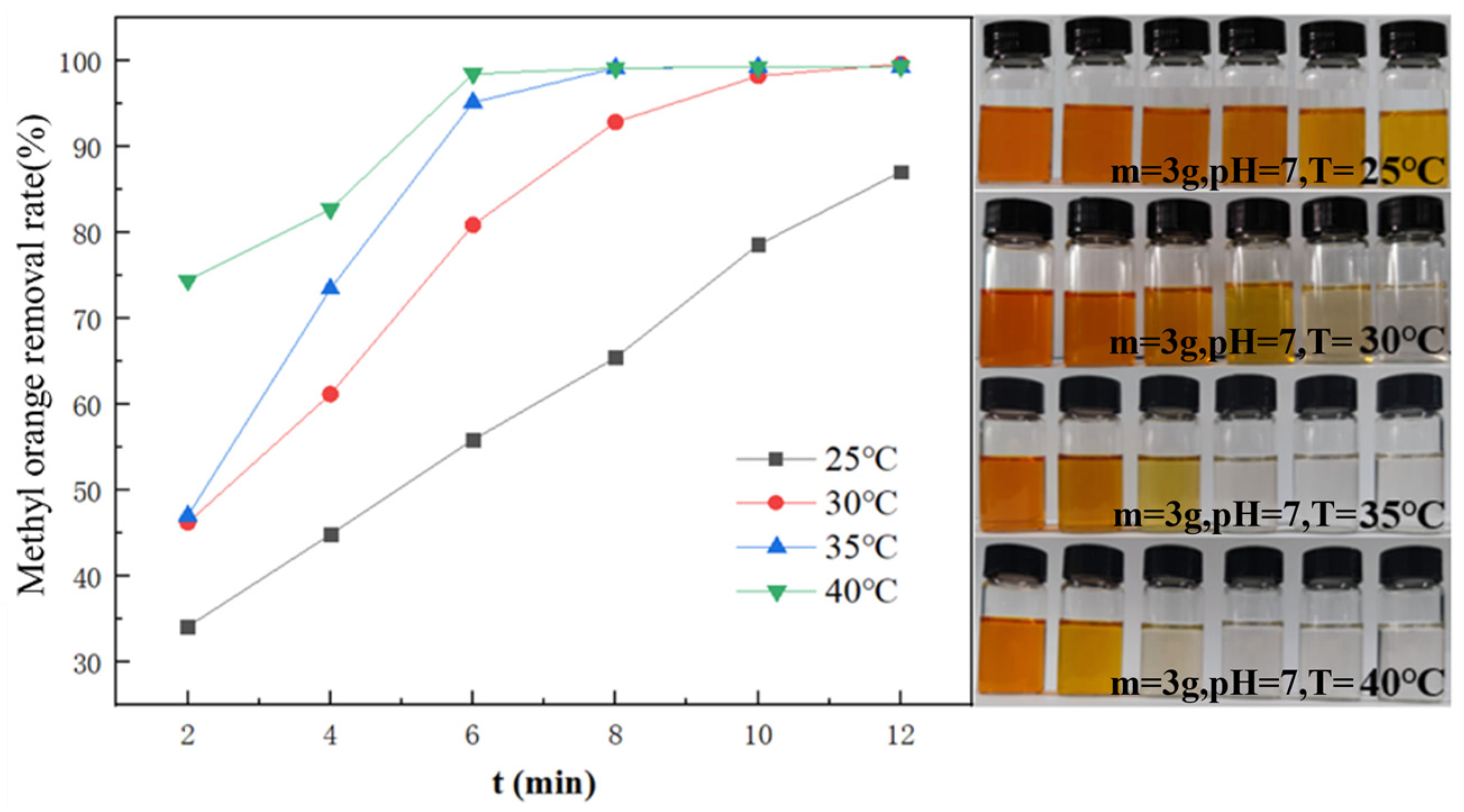
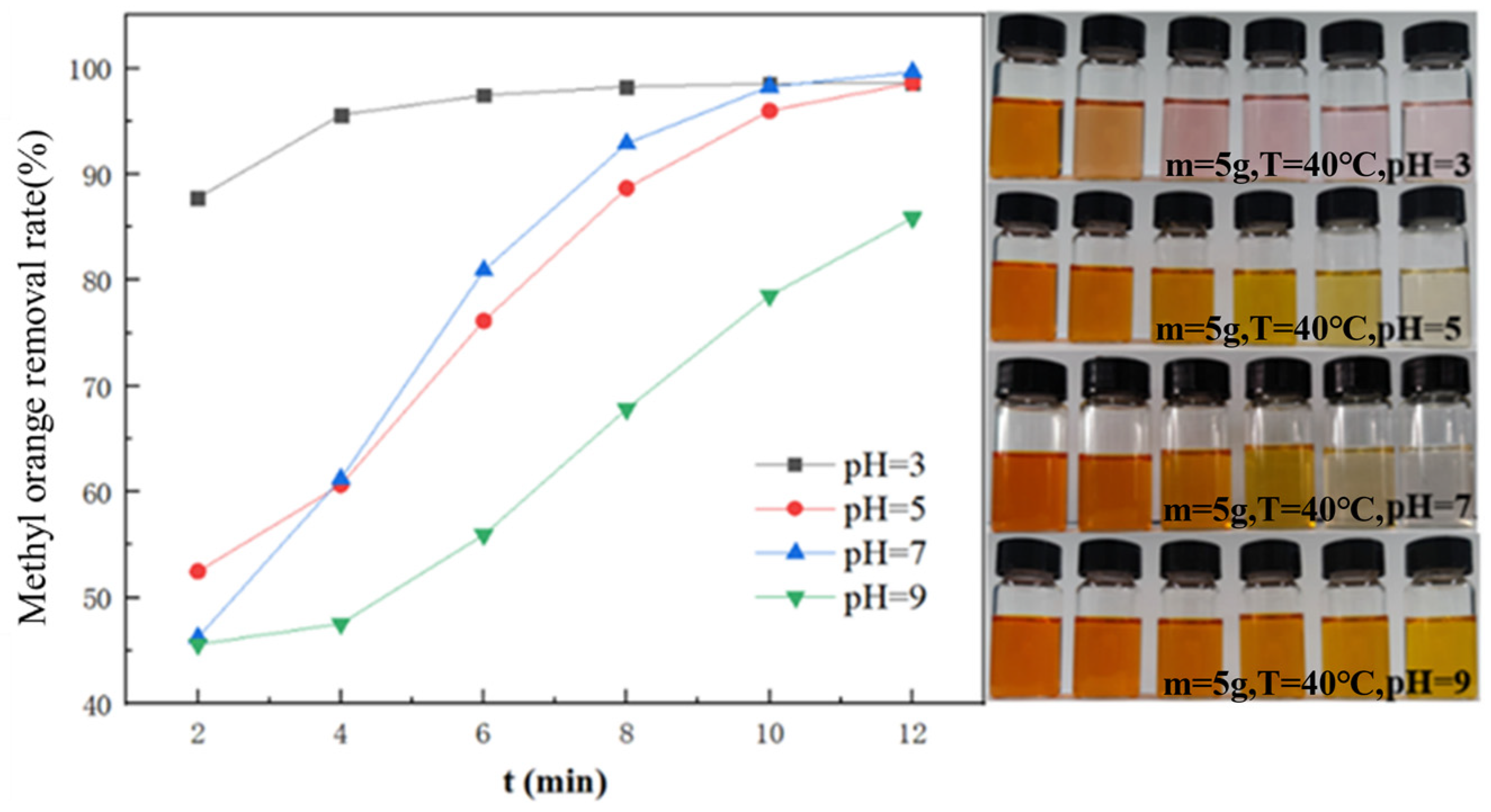
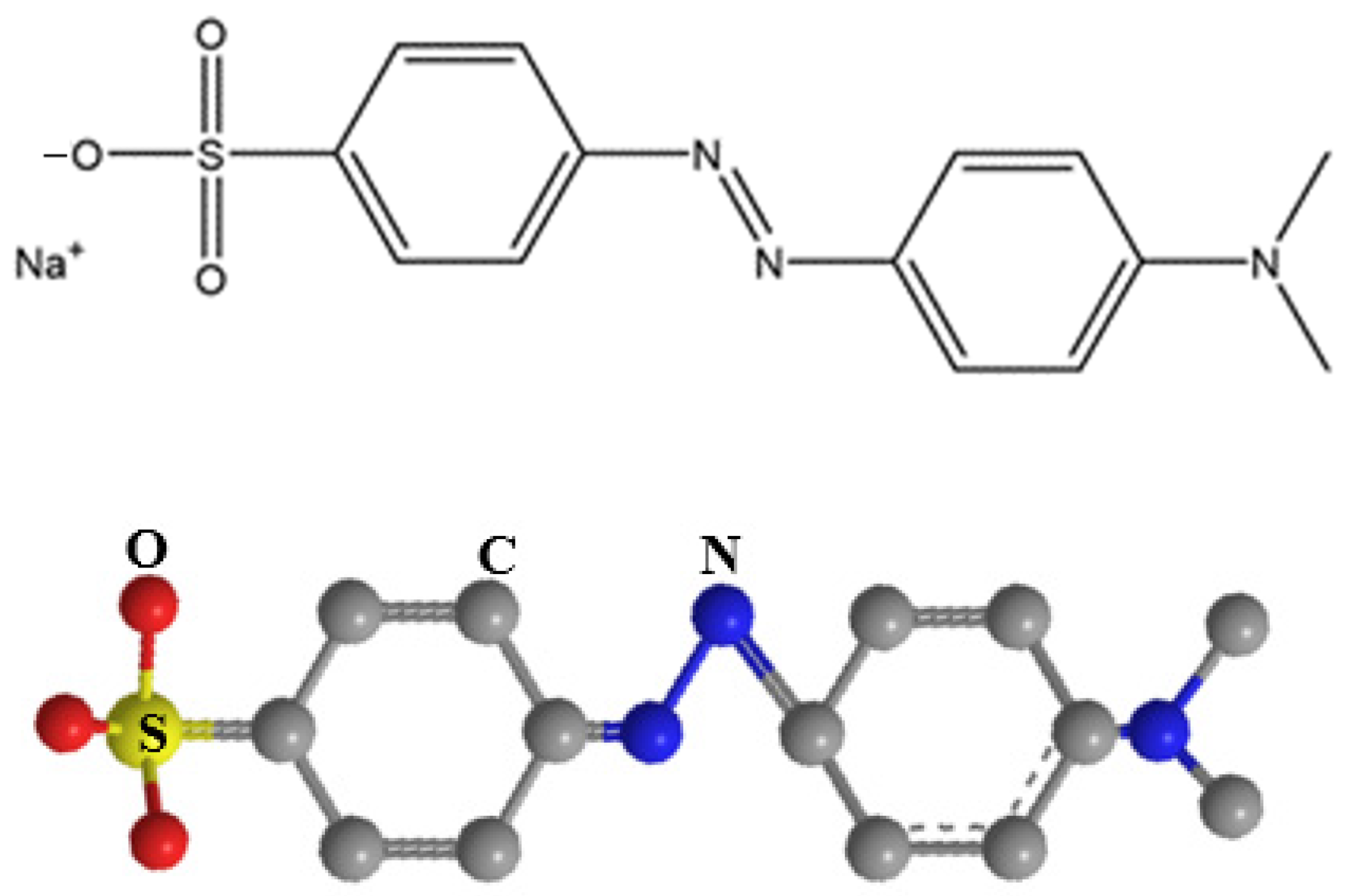

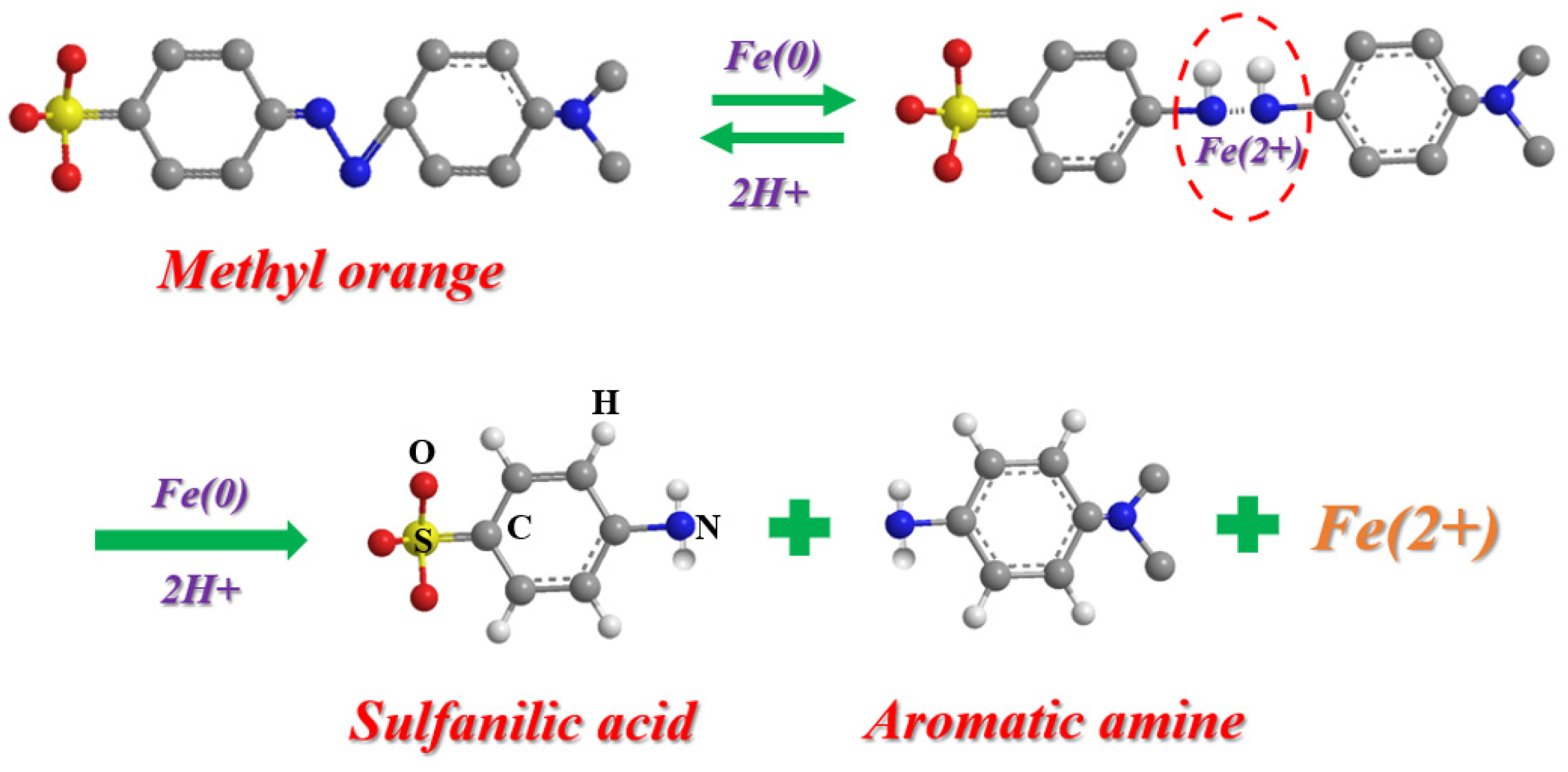
| Element | C | TFe | Zn | Pb | K2O | Na2O |
|---|---|---|---|---|---|---|
| Content | 45.70 | 23.27 | 0.46 | 0.05 | 0.52 | 0.50 |
| Element | TFe | FeO | SiO2 | CaO | Al2O3 | MgO | P | S |
|---|---|---|---|---|---|---|---|---|
| Content | 55.15 | 0.82 | 11.59 | 0.19 | 4.55 | 0.34 | 0.134 | 0.022 |
| Samples | Proximate Analysis | Ultimate Analysis | |||||||
|---|---|---|---|---|---|---|---|---|---|
| Coal tar pitch | FCad | Vad | Mad | Aad | C | H | O | N | S |
| Samples | 51.64 | 37.46 | 2.63 | 8.27 | 91.81 | 3.82 | 2.72 | 0.73 | 0.68 |
| Samples | Fe:C 1:1 | Fe:C 1:1.5 | Fe:C 1:2 | Fe:C 1:2.5 | Fe:C 1:3 |
|---|---|---|---|---|---|
| Blast furnace dust/% | 9.2 | 16.3 | 22.7 | 28.4 | 39 |
| Iron ore powder/% | 70.8 | 63.7 | 57.3 | 51.6 | 41 |
| Coal tar pitch/% | 20 | 20 | 20 | 20 | 20 |
Disclaimer/Publisher’s Note: The statements, opinions and data contained in all publications are solely those of the individual author(s) and contributor(s) and not of MDPI and/or the editor(s). MDPI and/or the editor(s) disclaim responsibility for any injury to people or property resulting from any ideas, methods, instructions or products referred to in the content. |
© 2023 by the authors. Licensee MDPI, Basel, Switzerland. This article is an open access article distributed under the terms and conditions of the Creative Commons Attribution (CC BY) license (https://creativecommons.org/licenses/by/4.0/).
Share and Cite
Xu, R.; Zhang, Y.; Huang, X.; Cao, M.; Yu, J.; Zhang, J.; Zheng, H.; Schenk, J. Preparation of Micro-Electrolytic Iron-Carbon Filler for Sewage by Recycling Metallurgical Dust. Metals 2023, 13, 673. https://doi.org/10.3390/met13040673
Xu R, Zhang Y, Huang X, Cao M, Yu J, Zhang J, Zheng H, Schenk J. Preparation of Micro-Electrolytic Iron-Carbon Filler for Sewage by Recycling Metallurgical Dust. Metals. 2023; 13(4):673. https://doi.org/10.3390/met13040673
Chicago/Turabian StyleXu, Runsheng, Yuchen Zhang, Xiaoming Huang, Minghui Cao, Jiyong Yu, Jianliang Zhang, Heng Zheng, and Johannes Schenk. 2023. "Preparation of Micro-Electrolytic Iron-Carbon Filler for Sewage by Recycling Metallurgical Dust" Metals 13, no. 4: 673. https://doi.org/10.3390/met13040673






